Le
Mans Series 2008
Round 4. Nürburgring 1000 Kilometres. August 16th -
17th 2008
Weekend Preview
Castles,
forests and mountains - Nürburg in the Eifel Region
of Germany
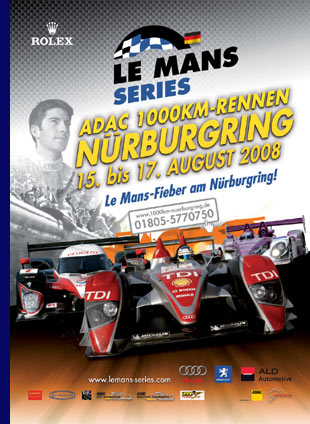 After
a gap of some fourteen weeks, the Le Mans Series reaches
the Nürburgring in Germany for Round Four of the 2008
championship. In the months since the Spa 1000 Kilometres
in May most of the teams have been far from idle, with nearly
all the leading contenders also taking part in the Le Mans
24 Hours in June and a handful also braving the 24 Hours
of Spa in early August – although largely in cars
they don’t usually field in the Le Mans Series.
After
a gap of some fourteen weeks, the Le Mans Series reaches
the Nürburgring in Germany for Round Four of the 2008
championship. In the months since the Spa 1000 Kilometres
in May most of the teams have been far from idle, with nearly
all the leading contenders also taking part in the Le Mans
24 Hours in June and a handful also braving the 24 Hours
of Spa in early August – although largely in cars
they don’t usually field in the Le Mans Series.
In
Germany, Peugeot will be out to avenge their defeat by Audi
at Le Mans – an embarrassment perhaps made all the
more painful by the high profile advertising campaign that
gloated on three successive wins by the French marque in
the opening rounds of the Le Mans Series. The tone of the
advertising of late has been slightly less gung-ho, but
a return to winning ways will be the least that the 908s
can be hoping to achieve on Audi’s home turf. On the
flipside of that argument, playing to the home crowd may
spur Audi on as they attempt to wrest a first win in the
Le Mans Series, perhaps ahead of any official announcement
that the R10 is to be retired at the end of this season.
Aerodynamic tweaks introduced for Spa helped, but not enough
to prevent another Pug win. News of an R10 replacement is
expected from Audi in October.
One
item of very good news is the likely return to the Creation
cockpit of Jamie Campbell-Walter. The ebullient JCW has
been out of action since breaking several vertebrae in an
horrendous accident at Monza, but he safely endured a test
at Estoril in Spain in mid-July and then followed that with
another good run at Snetterton at the end of the month.
Having proved his fitness for duty, he will co-drive with
Stuart Hall. The team also announced, just a few days before
the race, that American Liz Halliday will step in to the
seat vacated, temporarily, by Felipe Ortiz. She will partner
Stephen Simpson (South African A1GP driver) and her addition
to the squad will mean that Vanina Ickx is no longer the
only female driver on the grid.
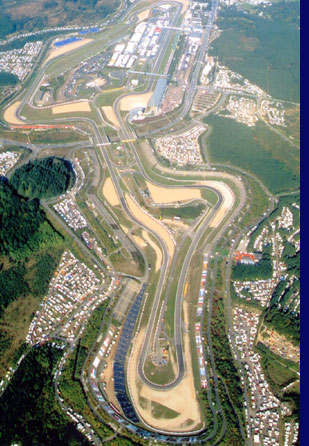 At
the time of writing there have been few major announcements
concerning competitors in LMP2, although Embassy Racing
will be bringing back Darren Manning to the squad. He replaces
Mario Haberfield, who has commitments elsewhere, and will
partner Warren Hughes in the #45 Embassy WF01 Zytek. Darren
shared the team’s Radical with Hughes in 2007 and
has been running high in America, scoring podiums in the
IndyCar series. Date clashes there prevented a full season
with Embassy, but he’s likely to stay with the team
for the last two races.
At
the time of writing there have been few major announcements
concerning competitors in LMP2, although Embassy Racing
will be bringing back Darren Manning to the squad. He replaces
Mario Haberfield, who has commitments elsewhere, and will
partner Warren Hughes in the #45 Embassy WF01 Zytek. Darren
shared the team’s Radical with Hughes in 2007 and
has been running high in America, scoring podiums in the
IndyCar series. Date clashes there prevented a full season
with Embassy, but he’s likely to stay with the team
for the last two races.
Kruse
will be another outfit looking for a far better run in their
homeland. The Mazda-powered Lola has had a pretty torrid
time of late, with accidents in Belgium (Jean de Pourtales)
that prevented any participation in the Spa 1000 Kilometres,
and then that frightening barrel-roll for Hideki Noda during
qualifying at Le Mans. A sterling effort from Lola saw the
car rebuilt in time for the race, but then retirement came
after 147 laps.
Although
the teams running them are respectively Dutch, Danish and
Swiss, the three Porsche LMP2 squads of Van Merksteijn Motorsport,
Team Essex and Horag Racing can also be expected to be on
top form at the Nürburgring. With Stuttgart just down
the road, so to speak, Porsche will pull no punches in ensuring
that their cars top the timing screens come qualifying.
A win in the Le Mans 24 Hours for Van Merksteijn and a second
place for Team Essex has assured the Spyder of a memorable
debut season in Europe, but they still have to battle it
out for top honours in the Le Mans Series. Horag missed
a Le Mans entry this year, but won’t be far behind
the other two in the 1000 Kilometres.
Elsewhere
in LMP2, there is little news of significant change. Racing
Box seemed unlikely to be returning to the series after
the team's Lucchini made a late exit during scrutineering
for the Le Mans 24 Hours. The car did arrive in the Nurburgring
paddock, where it joined a second Lucchini, that of Ranieri
Randaccio, but as a result of homologation issues, neither
car will take part in the weekend's 1000 Kilometres. There
had also been some questions over the on-going presence
of the WR Salini Zytek, but the car is also present at the
Nurburgring and scheduled to race.
So,
much of the field will pick up where they left off in May,
with the Speedy Sebah Lola Coupé (retirement after
194 laps at Le Mans) and RML’s own MG Lola EX265 (ditto
100 laps) the most likely to be taking the pace to the Porsches,
harried no doubt by the ASM Lola and Embassy’s pair
of WF01 Zyteks.
With
the withdrawal of the two Lucchinis, and also the absence
of the James Watt Automotive Aston Martin Vantage GT2, the
total field for the 1000 Kilometres will be 46.
Other
News
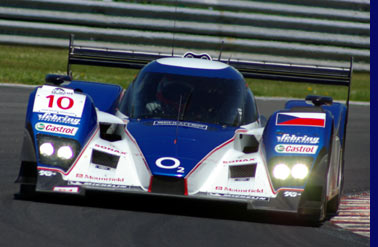 Following
Le Mans there was a hint from David Richards that Aston
Martin is now eyeing a future in LMP2. Having already achieved
representation in almost every other category of sportscar
and GT racing, LMP2 is the only obvious gap left in the
marque’s repertoire, but the first phase is likely
to concentrate on the provision of a new powerplant.
Following
Le Mans there was a hint from David Richards that Aston
Martin is now eyeing a future in LMP2. Having already achieved
representation in almost every other category of sportscar
and GT racing, LMP2 is the only obvious gap left in the
marque’s repertoire, but the first phase is likely
to concentrate on the provision of a new powerplant.
The
Aston Martin V8 powered Charouz Lola LMP1 Coupé (left)
has already demonstrated considerable pace and potential,
but clearly has some technical issues to be addressed before
reliability brings the results the car clearly deserves.
Further intimations at a closer involvement by the factory
in the LMP1 project were deftly side-stepped by Richards,
but the possibility remains.
Much
debate has been raised of recent weeks concerning the pace
and stability of LMP1 and LMP2 prototypes under existing
Le Mans regulations (see separate news item) and the ACO
confirmed in late June that serious consideration is being
given to schemes that will not only slow down the LMP cars,
but also reduce their propensity to get airborne. Having
previously announced that the ideal “perfect lap”
of the Le Mans circuit should be achieved in around three-and-a-half-minutes,
there was consternation in race control in June when Peugeots
and Audis were clocking times in the low 3:20s and quicker,
while both the Charouz Lola and Dome also beat the 3:30
barrier. The diesel-powered cars seem likely to have their
power restricted, while aerodynamic changes are being mooted
for both LMP1 and LMP2. However, such changes are unlikely
to be enforced before the start of next season.
In
addition to adjustments in technical regulations, there
are also suggestions that subtle changes may also be introduced
to the way teams carry out pitstops, and also the formulation
of driver line-ups. There is enormous pressure on teams
to carry out refuelling and tyre changes as quickly as possible,
with a few seconds in the pits often being easier to gain
than the same time benefit on track. It is no secret that
the ACO is considering the imposition of a minimum time
for certain aspects of the pitstop, such as wheel and tyre
changes, but details are unlikely to be given until later
in the year.
The
rumour mill continues to revolve with regard to the composition
of driver squads, typically spitting out chaff and misinformation,
but nevertheless, giving further credence to the understanding
that major changes are being considered for LMP2. Current
thoughts suggest that a maximum of one professional driver
per car is a possible rule-change for 2009, and also the
prohibition of direct factory involvement in the class.
The pro-am approach to sportscar and GT racing has long
been a popular one, and while factory squads and all-pro
driver line-ups are considered acceptable in the upper categories
of prototype and GT racing, LMP2 and GT2 have long been
considered the domain of the “gentleman driver”.
In a further attempt to emphasise the demarcation between
the classes, the ACO is believed to be considering a return
to such a regulation for next season.
During
the Le Mans week the ACO announced a new feeder series for
budding prototype racers. Forged around a one-make open-topped
LMP style racecar, Formula Le Mans will be a significant
new championship to act as a support for the Le Mans Series.
The cars are to be developed by Oreca at their factory in
Le Mans, and should be in full production within the next
six to eight weeks. Powered by a stock V8 engine generating
around 400 bhp, the cars are emphatically not intended
to represent a new LMP3 category, insists the ACO, but should
offer cost-effecting opportunities for up-and-coming young
drivers. A fourteen-race calendar is being prepared for
2009, based around two races each at the five Le Mans Series
rounds, plus two other European-based events. If successful
- and there seems little doubt that it will be – the
concept will then expand into America and Asia in 2010.
This
dovetails with the announcement earlier in the year that
the race originally scheduled for Shanghai in October 2008
has been postponed until 2009, and will now take place in
early November, following the re-launch of what may become
the ACO’s Japanese Le Mans Series at the Fuji International
Speedway circuit at the end of October. Discussions are
well in hand to see the series expand throughout Asia in
2010, perhaps with races in Malaysia and India.
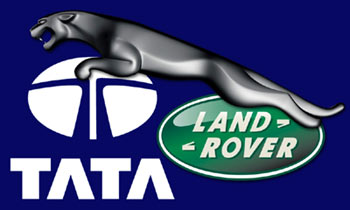 Interest
in sportscar racing in India has soared following Tata’s
acquisition of Jaguar earlier this year. It was widely known
that Tata had been in talks with Richard Lloyd and Apex
Motorsport concerning the future of the team's Jaguar XKR
project, with every likelihood that factory involvement
would be following on swiftly from the car’s early
signs of promise. The tragic deaths of both Richard Lloyd
and the car’s chief development driver David Leslie
in April brought all that hard work and future prospect
into question, but in July there was a tantalising re-opening
of the door by Tata chairman Ratan Tata. “We want
to hit the Le Mans race, for which we are already re-examining
whether we can bring back the Jaguar brand to its earlier
state," he said, speaking at the company’s AGM
(July 25th). The $2.3 billion acquisition of Jaguar and
Land Rover (completed on 2nd June 2008) has made Tata Motors
the world's 17th largest automobile maker, up from 30th
place. Along with the Jaguar and Land Rover brands, Tata
also takes control of Daimler and the dormant Lanchester
and Rover names.
Interest
in sportscar racing in India has soared following Tata’s
acquisition of Jaguar earlier this year. It was widely known
that Tata had been in talks with Richard Lloyd and Apex
Motorsport concerning the future of the team's Jaguar XKR
project, with every likelihood that factory involvement
would be following on swiftly from the car’s early
signs of promise. The tragic deaths of both Richard Lloyd
and the car’s chief development driver David Leslie
in April brought all that hard work and future prospect
into question, but in July there was a tantalising re-opening
of the door by Tata chairman Ratan Tata. “We want
to hit the Le Mans race, for which we are already re-examining
whether we can bring back the Jaguar brand to its earlier
state," he said, speaking at the company’s AGM
(July 25th). The $2.3 billion acquisition of Jaguar and
Land Rover (completed on 2nd June 2008) has made Tata Motors
the world's 17th largest automobile maker, up from 30th
place. Along with the Jaguar and Land Rover brands, Tata
also takes control of Daimler and the dormant Lanchester
and Rover names.
The
Circuit
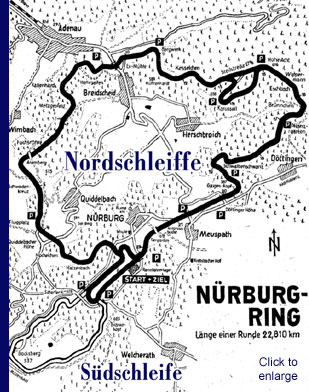 It
would be impossible to conclude a roundup of recent news
and a preview of the Nürburgring 1000 Kilometres without
some reference to the circuit itself.
It
would be impossible to conclude a roundup of recent news
and a preview of the Nürburgring 1000 Kilometres without
some reference to the circuit itself.
The
track used for the Le Mans Series race, the Grand Prix circuit,
was created in 1984, and modified by the addition of the
Mercedes Arena in 2002 (see photograph above).
This created a track of just over five kilometres (3.2 miles)
that currently shares duties as venue for the German Grand
Prix with the Hockenheimring. It’s a good spectator
track, with many vantage points and sufficient changes in
elevation to provide interest and entertainment, but it
is often considered too technical by drivers, lacking in
character and with no “heart”. This is as much
due to the close proximity of the fabled Nordschleife as
anything else, beside which even the finest of modern circuits
might pale. It is also one reason why the track is sometimes
referred to as the Eifelring, rather than the “Nürburgring”,
which is seen as a title that harks back to the glory days
of the original circuit.
Widely
regarded as the most challenging (and perhaps most dangerous)
motor racing circuit anywhere in the world – and certainly
so if one considers that it is still used – the Nordschleife
last hosted a Formula 1 Grand Prix in 1976 – the year
of Nikki Lauda’s fiery crash - and the chequered flag
fell on the final motorbike Grand Prix in 1980. Since then
the circuit has remained in less regular use for motor racing,
although the annual Nürburgring 24 Hours is still raced
over the full circuit – but it is busy almost every
day as enthusiasts and track-day racers pay a modest 21€
per lap to punish their cars almost to oblivion –
and sometimes beyond. It is extraordinary to think that
even a complete novice can turn up at the entrance gate,
part with a few notes, and head out onto one of the most
famous motor racing circuit in the world. Many do not return.
Official figures are hard to come by, but it is believed
that between 5 and 10 people are killed every year on the
Nordschleife.
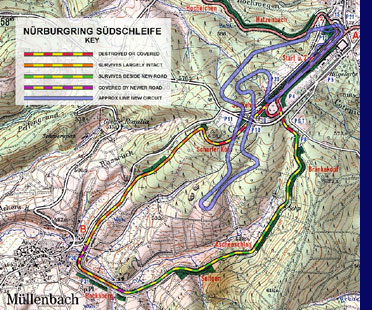 Although
monstrously long today, the original Nürburgring was
longer still and was split into three configurations. The
entire track, the Gesamtstrecke (see map above)
was 28.3 kilometres in length, but comprised the Nordschleife
(22.8 kms), the Südschleife (7.7 kms), and the Betonschleife
– the latter a short 2 kilometer warm-up loop around
the pit area. (Note that the lengths of the two, when considered
separately, add up to more than the whole, since each circuit
effectively shared the Betonschleife.)
Although
monstrously long today, the original Nürburgring was
longer still and was split into three configurations. The
entire track, the Gesamtstrecke (see map above)
was 28.3 kilometres in length, but comprised the Nordschleife
(22.8 kms), the Südschleife (7.7 kms), and the Betonschleife
– the latter a short 2 kilometer warm-up loop around
the pit area. (Note that the lengths of the two, when considered
separately, add up to more than the whole, since each circuit
effectively shared the Betonschleife.)
Originally
the two Schleifes had been separate circuits, hosting their
own independent race meetings but able to be joined into
one when the occasion demanded. Of the two, the Nordschleife
always had the greater appeal - it was longer, hosted more
events, and had some very tricky sections right from the
start. Its smaller cousin to the south was invariably the
poor relation, although the late Paul Frère always
maintained that it was much underrated. Click on either
map (above) to view an enlargement.
Opened
in 1927, some of the Südschleife has been lost over
the years – to car parks at the circuit, the newer
Grand Prix track itself and public enclosures – but
a large amount still survives and can be traced by the intrepid.
The eastern half runs alongside what is now a public road,
and can be glimpsed through the trees where it digs deeper
into hillsides and follows an older, more forgotten route.
At the extreme south the newer road bypasses Müllenbach,
while the old Südschleife continues on towards a right-angled
bend nearer the edge of the town. There it briefly disappears
completely, before resurfacing north-east of the junction
with the bypass. Just north of here it is possible to drive
off the main road and join the old racetrack, heading north-east
towards the castle, swinging round beneath the lofty mound
before having to stop at the point where the new circuit
cuts across the vestigial track. The only section that remains
in use for racing is the original pit straight - still the
main start-line straight today.
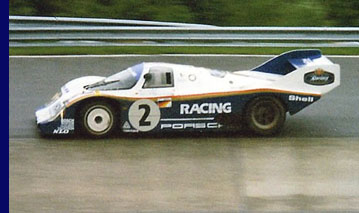 By
contrast, the Nordschleife survives intact, and continues
to attract fresh record attempts on a regular basis. The
outright lap record was set by Stefan Bellof (right)
at the wheel of the #2 Rothmans Porsche 956 in May 1983.
It stands at 6 minutes 11.13 seconds. Bellof, widely considered
to be one of the finest young talents of his day, was tragically
killed in another Porsche at Eau Rouge, Spa, two years later.
By
contrast, the Nordschleife survives intact, and continues
to attract fresh record attempts on a regular basis. The
outright lap record was set by Stefan Bellof (right)
at the wheel of the #2 Rothmans Porsche 956 in May 1983.
It stands at 6 minutes 11.13 seconds. Bellof, widely considered
to be one of the finest young talents of his day, was tragically
killed in another Porsche at Eau Rouge, Spa, two years later.
The
fastest lap by a semi-road legal car was set in 2005 by
Michael Vergers (co-driver of the Barazi Zytek in the Le
Mans Series) in a Radical SR8. His time of 6:55 has since,
reputedly, been beaten by almost two seconds by an unknown
driver in an Aerial Atom 500, but the claim has not been
validated. The undisputed record by a fully road-legal car
is 7:29.03 set by Toshio Suzuki in a Nissan GTR in April
2008, although there is a manufacturer’s claim of
7:27.92 by Pagani for a Zonda (Marc Basseng driving) and
another dubious claim of of 7:26.4 from Jim Mero in a Chevrolet
Corvette C6 ZR1. No doubt there will be further attempts
during the coming weeks.
As
if the appeal of the Ring in itself was not enough, there
are plans to build the world’s fastest roller-coaster
ride at the Nürburgring. Under the working title of
the RingoRacer, construction is expected to begin
later this year. When finished the Formula 1-inspired ride
will feature a pneumatic launch mechanism that will accelerate
screaming occupants from nought to 135 miles an hour in
2.5 seconds. Provisional opening is scheduled for June 2009.
Race
Coverage from the Nürburgring
Once
again, the race will be broadcast live by Radio Le Mans
- click the link below. Joining John in the commentary booth
this weekend will be Eurosport's regular voice Martin Haven,
with Nick Daman helping out from the pitlane.
TV
coverage for the race is extensive, with coverage of qualifying
and much of the race live, all followed by a series of "highlights"
programmes. Eurosport 2 begins on Saturday at 4:00 pm (3:00
pm UK time) with coverage of qualifying, and then the first
hour of the race on Sunday (12:00 pm - 1:00 pm (1:00 pm
- 2:00 pm UK time), mid-race (2:00 pm - 3.30 pm (1:00 pm
- 2.30 pm UK) and the final hour (starting at 5:0 pm (4:00
pm UK).
Motors
TV will also be covering the race live and in its entirety
across Europe, starting at 10.45 on Sunday for the UK, or
11.45 for the continent. More details can be found here.
Live
timing can be found here.
|
Live
radio coverage from John Hindhaugh, Nick Daman, Martin
Haven, Graham Tyler, Graham Goodwin and others. |
